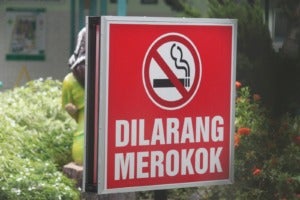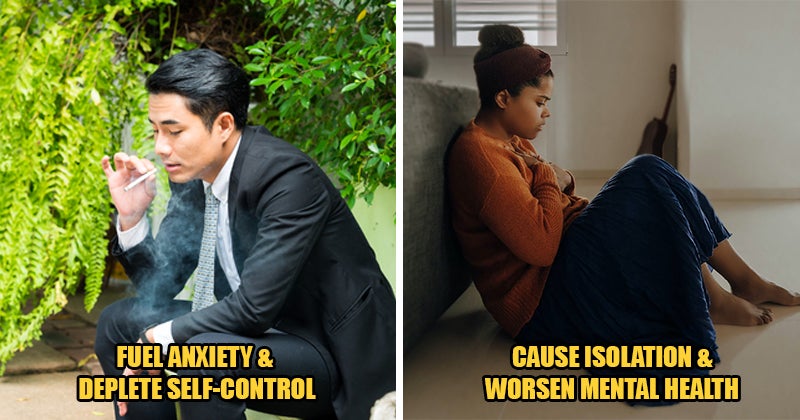Smokers are often deemed aggressive, selfish, and weak-minded. Like any other stereotype, these social stigmas against smokers threaten mental health and can do more harm than good!
In this article, we explore how stereotypes affect existing smokers and the alternative solutions to building a smoke-free nation. Keep on reading to find out how smokers are affected!
1. Fuel anxiety and deplete self-control
A study found that smokers confronted by negative stereotypes tended to smoke more frequently. In comparison to the others, these smokers reported higher levels of anxiety, which triggered the urge to smoke.
In other words, stigmatising and shaming smokers can fuel their anxiety, which depletes their self-control and thwarts quitting attempts.

2. Ignore cessation progress and causes demotivation
The cessation process can be highly challenging. Smokers may experience withdrawal symptoms such as intense cravings, irritability, and insomnia. Besides, they are also likely to develop mental health issues like anxiety and depression. As a result, smoking relapse is not uncommon among smokers who are trying to quit.
Stigmatising smokers, however, supports the assumption that the journey to quit smoking is a straight line (which is hardly the case). This overlooks their cessation progress and can lead to demotivation among smokers, hurting their efforts to quit smoking.

3. Encourage withdrawal from a support system
A support system refers to a network of people who can provide an individual with emotional and practical support. As social beings, having a support system is crucial in ensuring our mental well-being. Unfortunately, stigmatisation causes smoking to become socially unacceptable, leading to isolation among smokers.
Due to shame and guilt, many smokers tend to conceal their smoking status and withdraw from their social circles. Consequently, they might experience loneliness and low self-esteem due to the lack of social acceptance.

4. Increase the urge to smoke
Stigma can be far more destructive than we could imagine. It can result in discrimination, bullying, mental illness, and more. At the very least, stereotypes induce high-stress levels among stigmatised groups, including smokers.
Studies have shown that stress decreases executive function and increases cravings for rewarding substances. As a result, when experiencing stress, smokers have a stronger urge to smoke despite understanding the consequences of smoking.

5. Marginalise existing smokers
From school-based education programs to anti-smoking campaigns, many initiatives seek to reduce the number of smokers and improve public health. However, these initiatives focus more on discouraging non-smokers from smoking, while little attention is paid to helping existing smokers.
Consequently, existing smokers are marginalised when anti-smoking campaigns do not cultivate social support for smokers who are going through smoke cessation. For instance, the total ban on tobacco products proposed in the Control of Tobacco Product and Smoking Bill 2022 can be counterproductive due to the possible demand for illicit cigarettes among smokers.

Dr. Steven Chow, the president of the Federation of Private Medical Practitioners Associations Malaysia (FPMPAM), shares a similar opinion: “Rushing the GEG and excluding harm reduction from the policy would be a missed opportunity, as we may be losing out on an achievable option that can have a meaningful impact on the tobacco epidemic.”
Therefore, instead of stigmatising and marginalising smokers, focusing on Tobacco Harm Reduction can be a better alternative when building a smoke-free Malaysia.
Wait… what is Tobacco Harm Reduction?
Tobacco Harm Reduction (THR) is a public health strategy implemented to lower the health risks linked to the use of tobacco products.
This strategy acknowledges that banning tobacco products entirely may not be feasible due to factors like nicotine addiction, personal enjoyment, and illicit cigarette trades. Hence, THR encourages smokers to opt for smoke-free alternatives instead of cigarettes.

Smoke-free alternatives & their roles in THR
The burning of tobacco in cigarettes releases over 6,000 harmful chemicals, 100 of which are found to cause smoke-related diseases like lung cancer, cardiovascular diseases, and emphysema. Some of these harmful chemicals include:
- Cigarette tar: stains smokers’ teeth, nails, and fingers
- Carbon monoxide: reduces oxygen-carrying capacity in the bloodstream
- Carcinogen: cancer-causing

Unlike cigarettes, smoke-free alternatives such as e-cigarettes (vapes) and heated tobacco products (HTPs) heat tobacco. The absence of a combustion process makes smoke-free products less harmful than cigarettes:
- Mechanism
-
- Cigarettes: Burns tobacco at around 600°C, and releases smoke and ash.
- Smoke-free alternatives:
- Heated tobacco products (HTPs): Heats tobacco at below 350°C, which is not hot enough to produce smoke.
- Vapes: Heats up vape juice to release nicotine, does not involve combustion and will not produce smoke.
- Emissions
-
- Cigarettes: Releases smoke and ash which contain harmful chemicals that cause smoke-related diseases.
- Smoke-free alternatives:
- HTPs and vapes merely release aerosol, which is composed of water, glycerin, and nicotine.
- Since no combustion of tobacco is involved, aerosol will not cause smoke-related diseases.
- Passive smoking
-
- Cigarettes: Smoke and ash are also harmful to non-smokers who inhale cigarette emissions.
- Smoke-free alternatives:
- The aerosol produced by HTPs and vapes prevents non-smokers from being exposed to passive smoking via secondhand or thirdhand smoke.
- Aerosol also does not reduce indoor air quality.

All in all, although smoke-free alternatives still contain nicotine and are not completely risk-free, they can be less harmful alternatives for cigarette smokers who want to continue smoking or even wean off cigarettes completely. Such an approach has been proven effective in New Zealand, whereby smoke-free alternatives are used to help smokers quit.
Nevertheless, THR can be achieved when smokers switch to smoke-free alternatives and reduce their exposure to harmful chemicals. Ultimately, it is hoped that these smoke-free alternatives can help build a smoke-free Malaysia.





































